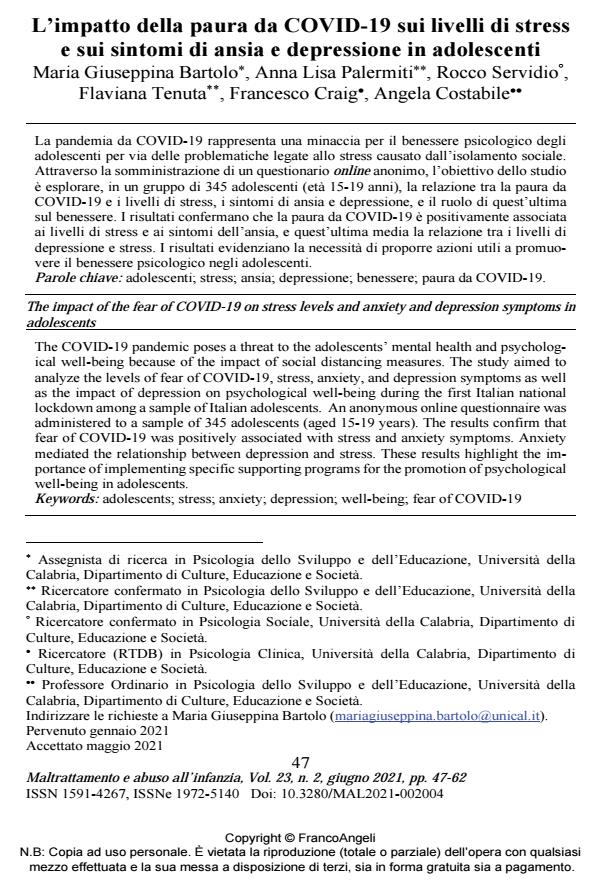L’impatto della paura da COVID-19 sui livelli di stress e sui sintomi di ansia e depressione in adolescenti
Titolo Rivista MALTRATTAMENTO E ABUSO ALL’INFANZIA
Autori/Curatori Maria Giuseppina Bartolo, Anna Lisa Palermiti, Rocco Servidio, Flaviana Tenuta, Francesco Craig, Angela Costabile
Anno di pubblicazione 2021 Fascicolo 2021/2
Lingua Italiano Numero pagine 16 P. 47-62 Dimensione file 243 KB
DOI 10.3280/MAL2021-002004
Il DOI è il codice a barre della proprietà intellettuale: per saperne di più
clicca qui
Qui sotto puoi vedere in anteprima la prima pagina di questo articolo.
Se questo articolo ti interessa, lo puoi acquistare (e scaricare in formato pdf) seguendo le facili indicazioni per acquistare il download credit. Acquista Download Credits per scaricare questo Articolo in formato PDF

FrancoAngeli è membro della Publishers International Linking Association, Inc (PILA)associazione indipendente e non profit per facilitare (attraverso i servizi tecnologici implementati da CrossRef.org) l’accesso degli studiosi ai contenuti digitali nelle pubblicazioni professionali e scientifiche
La pandemia da COVID-19 rappresenta una minaccia per il benessere psicologico degli adolescenti per via delle problematiche legate allo stress causato dall’isolamento sociale. Attraverso la somministrazione di un questionario online anonimo, l’obiettivo dello studio è esplorare, in un gruppo di 345 adolescenti (età 15-19 anni), la relazione tra la paura da COVID-19 e i livelli di stress, i sintomi di ansia e depressione, e il ruolo di quest’ultima sul benessere. I risultati confermano che la paura da COVID-19 è positivamente associata ai livelli di stress e ai sintomi dell’ansia, e quest’ultima media la relazione tra i livelli di de-pressione e stress. I risultati evidenziano la necessità di proporre azioni utili a promuovere il benessere psicologico negli adolescenti.
Parole chiave:adolescenti; stress; ansia; depressione; benessere; paura da COVID-19.
- Dealing with the post-pandemic challenges faced by youths and families: The perspectives of social workers Marco Carradore, Giorgio Gosetti, Cristina Lonardi, in Children and Youth Services Review 108117/2025 pp.108117
DOI: 10.1016/j.childyouth.2024.108117
Maria Giuseppina Bartolo, Anna Lisa Palermiti, Rocco Servidio, Flaviana Tenuta, Francesco Craig, Angela Costabile, L’impatto della paura da COVID-19 sui livelli di stress e sui sintomi di ansia e depressione in adolescenti in "MALTRATTAMENTO E ABUSO ALL’INFANZIA" 2/2021, pp 47-62, DOI: 10.3280/MAL2021-002004